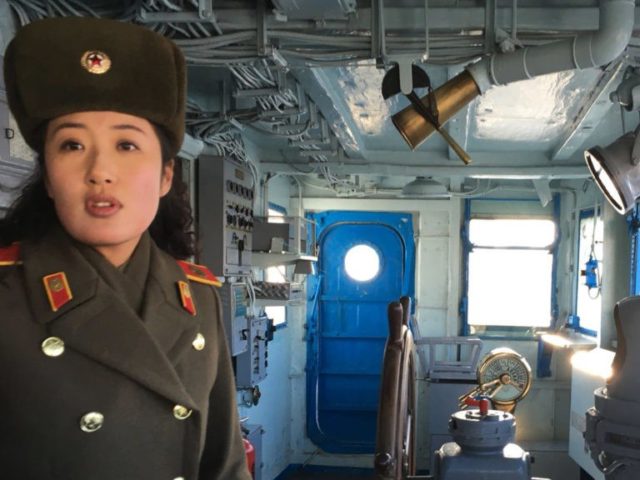As President Donald Trump prepares to meet on June 12 with North Korean dictator Kim Jong-un in Singapore, there is an issue independent of Pyongyang’s immediate denuclearization that could well allow Trump to determine the cut of Kim’s jib and how desperate he is to make a deal.
It involves an incident occurring half a century ago when North Korea seized an American “trophy.”
The USS Pueblo was a World War II-era freight and supply ship transferred to the U.S. Navy in 1966 and converted into a signal intelligence (spy) ship. In January 1968, she was dispatched off the coast of North Korea. The ship was lightly armed with several .50 caliber guns, some of which were not functioning properly due to the freezing temperatures. Contrary to international law that recognized a nation’s territorial water rights only extended twelve miles off its coast, North Korea claimed a fifty-mile limit.
Slightly after noon on January 23, Pueblo was sailing about sixteen miles off North Korea’s coast. Suddenly, she found herself surrounded by four North Korean vessels and ordered to heave to. Pueblo refused, but soon the challenge increased as two MIG-21 fighter jets and a fifth boat joined in, giving the North Korean threat additional teeth.
As Pueblo headed for the open sea, the North Koreans sought to force her landward. But when Pueblo slowed in a bid for more time, hoping the “cavalry” — planes from the aircraft carrier USS Enterprise — would arrive soon, the Koreans opened fire, killing one sailor. Pueblo was forced to head towards Wonsan Harbor. As it turned out, both the distance of Enterprise from Pueblo plus the absence of air-to-ground weaponry on her aircraft made rescue impossible.
As the Pueblo approached the twelve-mile territorial water limit, the North Koreans boarded her, immediately tying up and blindfolding all onboard. The crew would spend eleven months in prison before being released.
Pueblo’s loss was the first time since the War of 1812 a U.S. Navy ship was captured on the high seas. Today, the ship is still carried on the Navy’s list of active ships.
But Pueblo’s story did not end with its arrival in Wonsan Harbor. Despite the embarrassing loss of a U.S. Navy ship, an even more embarrassing fate was to befall her in 1999 — sadly, one occurring with U.S. cooperation.
During President Bill Clinton’s term in office, he desperately sought to make an agreement with Pyongyang to end its nuclear program. In October 1994, he announced he was able to reach a landmark deal, known as the “Agreed Framework,” with Pyongyang despite the standoff that had been created by the prior administration. He promised it would put an end to years of increasing nuclear tensions, assuring us, “This agreement represents the first step on the road to a nuclear-free Korean Peninsula.” It did not.
In the final months of Clinton’s administration, and as the Agreed Framework was not doing what Clinton represented it would do, additional negotiations ensued. As part of those negotiations, Pyongyang wanted to transfer the Pueblo from Wonsan, up the Taedong River, and on to Pyongyang. As this was a trip of over 1,000 nautical miles in international waters, North Korea sought U.S. assurances that, if the transit were undertaken, the U.S. would not intercept the ship.
Unbelievably, Clinton ordered the Navy to stand down and not intervene. In what must have been difficult for any sailor to observe, the Navy simply watched as its illegally seized ship was given free passage to Pyongyang. Once there, the North Koreans turned the vessel into one of the main attractions at its Victorious Fatherland Liberation War Museum.
Clearly, Pyongyang views Pueblo as a “trophy” it obtained by challenging a superpower proving unwilling to respond to North Korean aggression. Captured as a trophy under the rule of Kim’s grandfather, Kim Il-sung, and transferred as a trophy to be displayed in Pyongyang by Kim’s father, Kim Jong-il, the question arises whether Kim Jong-un would demand he retain possession of this trophy. If the U.S. demanded the ship’s release, whether Kim proved willing to do so would be most telling as to how desperate he is to make a deal. If Kim seriously wanted a deal he would run the risk of abandoning his “tough guy” image not only to the world but, more importantly for him, to his own military. Surrendering the trophy his grandfather won would not sit well with his military leaders.
The summit meeting between Trump and Kim has many layers. It is a meeting of superpower versus third world nation, of older leader versus younger leader, of contrasting agendas over forcing removal of a nuclear program versus keeping it, of the axis of good versus the axis of evil – as we cannot lose sight of the fact Kim kills people as easily as Trump fires them. The two leaders, like prizefighters, will circle each other seeking to take their opponent’s measure. But, by demanding Pueblo’s return, Trump should quickly be able to size up his opponent quickly.
Success in the summit may well turn on who returns home from Singapore with the “trophy” in hand.
Lt. Colonel James G. Zumwalt, USMC (Ret.), is a retired Marine infantry officer who served in the Vietnam war, the U.S. invasion of Panama and the first Gulf war. He is the author of “Bare Feet, Iron Will–Stories from the Other Side of Vietnam’s Battlefields,” “Living the Juche Lie: North Korea’s Kim Dynasty” and “Doomsday: Iran–The Clock is Ticking.” He frequently writes on foreign policy and defense issues.

COMMENTS
Please let us know if you're having issues with commenting.